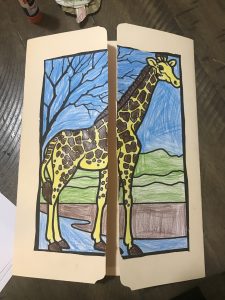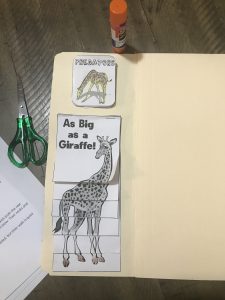The Homeschool Review Crew recently asked on Twitter
I responded
Upper elementary. Reading and basic math are mastered, but you’re not yet to the difficult upper level courses. Lots of fun things to do with the 3-4-5 grade crowd.
I stand by that, but I also think Kindergarten is pretty fun. When you’re not dealing with the frustrations of a child learning all their letters and sounds but being unable to put them together in random scenarios (i.e. outside of Reading Eggs), kindergartners are a great bunch. They have intense interests and very little can sway them from the things they like. This makes it an ideal time to really cater the schooling to those interests, thus creating a fun schooling environment and teaching them that learning is fun.
 Dragonfly loves giraffes. Like, really loves them. They’re his favorite animal by far. I don’t know where he developed that love, but I understand it (I love elephants in almost the same way). So I decided to hone in on that love with a kindergarten unit study for him. He and I have been spending the past week or so, and will spend the next week or two, learning all about giraffes. Under normal conditions, we would head to the library and get a stack of books, but we can’t really do that in the age of COVID. (Although, a quick online search tells me that our city library is actually open again with limited hours. I think I’ll head down there today!) Instead, we’re doing a lot of online research and relying on the information that came with our lap book from Homeschool Share.
Dragonfly loves giraffes. Like, really loves them. They’re his favorite animal by far. I don’t know where he developed that love, but I understand it (I love elephants in almost the same way). So I decided to hone in on that love with a kindergarten unit study for him. He and I have been spending the past week or so, and will spend the next week or two, learning all about giraffes. Under normal conditions, we would head to the library and get a stack of books, but we can’t really do that in the age of COVID. (Although, a quick online search tells me that our city library is actually open again with limited hours. I think I’ll head down there today!) Instead, we’re doing a lot of online research and relying on the information that came with our lap book from Homeschool Share.
Let me tell you a bit about Homeschool Share and how I use their resources with my kids. Homeschool Share is a website that’s chock full of homeschooling resources for a wide range of ages. I typically use them for finding the “fun” stuff – primarily lap books – for the younger kids. It was founded in 2004 by Ami, a homeschooling mom of two boys. She initially started it as a forum of sorts, where other homeschool moms could post unit studies they’d written for their own families in order to share and bless others. It quickly exploded, and there are now hundreds of unit studies, lap books, and printables – all available for free. The site is organized by subject, but there’s a search feature too, in case you want to find something specific for your child to learn about (as was the case with Dragonfly and giraffes). If you scroll down on the homepage, you can find the age breakdown of the resources (as opposed to the subject breakdown in the menu bar at the top). It’s really quite simple to poke around, and you’re almost guaranteed to find something you can use. The only “fee” for using the resources is signing up for the email list, but Ami isn’t one to spam your inbox every day.
 The giraffes lap book is perfect for a kindergarten student. It’s got 18 pages of mini books (some of them take up more than one page of printing; if I remember correctly, it was 15 mini books total). The entire study is self-contained, with the exception of additional books, which are, of course, optional especially in the digital age. But all the information you need to complete the mini books are included in the first couple of pages of the unit study, so for a basic, generic understanding of giraffes you don’t need anything more. The pages are black and white, which is perfect for allowing your child to color in all the giraffes. Some of them are already shaded, so there’s less to color on those mini books, making them ideal for the days when you don’t have quite as long to work.
The giraffes lap book is perfect for a kindergarten student. It’s got 18 pages of mini books (some of them take up more than one page of printing; if I remember correctly, it was 15 mini books total). The entire study is self-contained, with the exception of additional books, which are, of course, optional especially in the digital age. But all the information you need to complete the mini books are included in the first couple of pages of the unit study, so for a basic, generic understanding of giraffes you don’t need anything more. The pages are black and white, which is perfect for allowing your child to color in all the giraffes. Some of them are already shaded, so there’s less to color on those mini books, making them ideal for the days when you don’t have quite as long to work.
What will your student learn in their study of giraffes? Quite a bit for just a simple, 18-page file! Topics covered include giraffe-related vocabulary; giraffe anatomy; diet, predators, and defenses of giraffes; how giraffes live together in herds; names of the different genders of giraffes; fascinating facts about baby giraffes (for example, they are able to stand within 15 minutes of birth and are 6 feet tall when they are born); where giraffes live and what their habitat is like; the closest living relative of giraffes (there’s only 1 known relative of giraffes, the okapi); and miscellaneous fun facts. Did you know that giraffes have such large shoulder muscles because they run “front wheel drive” instead of “rear wheel drive” like most other animals?
In addition to learning about giraffes specifically, one of the things I really like about this lap book is the opportunity students are given to practice their handwriting skills. Dragonfly is still working on reading better, but he’s getting pretty darn good at copying letters from one page onto another in his own handwriting. These papers will make for lovely keepsakes when he’s older.
When Dragonfly and I finish up learning about giraffes, we’re going to utilize the other African animal lap books from Homeschool Share and continue this line of study for quite a while longer. It’s such a fun way to learn (and teach)!
What’s your favorite animal?
Blessings,


